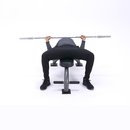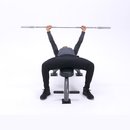Part 1 | Part 2 | Part 3 | Part 4
It was more than three decades ago that Arnold Schwarzenegger last trained for a competition (1980 to be exact), but even today many young bodybuilders point to The Oak as their biggest source of inspiration.
Though the black-and-white images have long faded on the walls of hardcore Southern California gyms, the training philosophies that built the world's greatest bodybuilder live on. In this, the second exclusive installment exploring Arnold's training, we focus on his chest and back workout.
Arnold paired chest with back, which are antagonist muscle groups; while one contracts, the other is stretched. Though they are both very large muscle groups, Arnold followed a high-volume, high-frequency approach, performing this workout three times per week. If that wasn't demanding enough, he typically came into the gym later in the evening for his thigh workouts!
Here's a closer look at the specific techniques and approaches that helped lay the foundation for his superhuman gains.
Arnold's Chest Training
Arnold pecs were truly impressive, even as teenager. It was always one of his strong body parts. Arnold prioritized chest training; he did it first in his training when fatigue levels were low so he could train it with maximum intensity.
"I seemed to train my chest hard and correctly from the beginning," he wrote. "My chest grew because I gave it the most attention, placing it first in my workout."
Here are some of Arnold's best chest-training tips culled from the many articles he wrote and interviews he gave over the years.
Arnold competed as a powerlifter early in his career, so building a big chest started with training for strength. Arnold's top weights on the bench included a 500-pound single and 405 for 8 reps. Arnold once did a 225-pound bench for 60 reps!
Arnold believed the concept of progressive overload was critical to building his pecs. "I strongly believe that the size of your muscles grows with the size of the weights you're using for repetitions."
Arnold included basic multi-joint movements in his routine that hit the pecs from every angle, which he knew would lead to optimal pec development from top to bottom. "I knew the routine had to be basic and very heavy."
Arnold hit every body part, not just chest, with high volume and frequency. His offseason routine consisted of up to 26 working sets on a high-volume day, and he trained his pecs three days per week, taking at least 48 hours off between workouts for recovery. That kind of volume and frequency suited The Oak during his competitive years, but for anyone with a full-time job, it's likely to induce significant jumps in cortisol levels and fatigue. Cycle short periods of high volume or high frequency training into your workout on occasion, but listen to your body for signs of overtraining. Arnold also cycled heavy and light days to both work the muscles with different relative intensities and ensure he wasn't overtraining his pecs.
Once you become familiar with the various basic movements in the gym, evaluate your weaknesses and try variations of basic exercises. "Not everybody responds to the bench press. You need to determine for yourself which are the best exercises for your body." Other variations he commonly tried included using slightly closer or wider grips on the barbell to move the area of emphasis in or out a few degrees.
Know the advantages of dumbbells and barbells, but use both in your training. "I feel a better stretch when doing dumbbells, especially with incline movements. The dumbbells can be lowered deeper than a barbell." This is important because a muscle that's fully stretched is capable of a stronger contraction, so long as you don't overstretch the shoulder joint.
Arnold commonly started with 1-2 warm-up sets and then increased the weight on succeeding sets (called a pyramid set) while decreasing the reps. Still, he trained in a fairly low rep range, often starting at 12 and working his way down to six.
Arnold believed that a lack of focus and concentration was the biggest mistake bodybuilders made when hitting chest. "Flex your pectoral muscles throughout the movement, but especially at the top." Contracting your pecs hard at the top increases the intensity of the movement.
Arnold's Back Training
It would be a mistake to think the "back" consists of a single muscle. It's a group that includes the middle and lower traps, rhomboids, the upper and lower portions of the latissimus dorsi, the erectors (low back), and even the rear delts. Arnold's approach to this complex group came from all angles.
When he began competing at the elite level, Arnold's back wasn't as imposing as his mammoth chest and arms. By employing basic, multi-joint movements to target all areas of his back, he was able to bring it up.
Here are some the basic principles Arnold followed when training back.
Arnold typically broke his back training into two types of movements: chinning and pull-downs for lat width, and rows for overall thickness. Lat pull-downs and pull-ups build a strong V-taper, while rows and bent-over movements better target the middle-back musculature.
Chins with an underhand grip and pull-ups were a big part of Arnold's approach to building wide lats. He also varied his grip width, went up to the bar behind his head and to his chest, and sometimes used added resistance or simply his bodyweight. The net result was an assault the worked the lats from multiple angles for better overall development.
"Wide-grip pull-ups coax the upper lats to come out," Arnold said. With wide-grip movements, the elbows stay out away from the sides, meaning the upper lats become the focus. With close-grip and reverse-grip back exercises, the elbows stay in tighter to the sides; this reduces the emphasis on the upper lats and instead places more of the focus on the lower lats.
One technique Arnold favored was to shoot for a total number of chins, say 50, rather than target a particular number of sets. "On the first set you may do 10 reps. Perhaps you struggle with 8 reps on the second set. You have 18 reps now. If you make 5 on the third set, you have 23 reps. You continue to add them until you reach 50, even though it may take you 20 sets to do it. That's how I built up my chinning power, and I was very successful with it."
For Arnold, with chins or with any other back move, gains in strength meant he'd have to increase the weight. "After you've mastered 10-12 reps in any type of chin, then you can start to put weight around your waist." Arnold argued that just increasing the number of reps you do as you get stronger wasn't as beneficial to the bodybuilder looking to maximize muscle growth as increasing the resistance.
Not everyone can do chins or pull-ups with their bodyweight. Arnold recommended using the pull-down machine until your strength levels increase. Once you can do at least 8 reps with the equivalent of your bodyweight, he suggested switching over to the chinning bar.
Exercises in which you pull the weight perpendicularly into your body—often called rows—were also a big part of Arnold's back workout. He favored all kinds of variations—seated cables rows, T-bar rows, bent-over barbell rows—but again each one was done with high volume and progressively heavier weights, pyramiding the weight up on successive sets for fewer reps.
Between sets, Arnold stretched out his lats, either hanging from a bar or holding on to a stable object and leaning away. Stretching helped maintain the flexibility around the joint. He often tensed his lats between sets as well, contracting the muscle as hard as he could to help achieve a superior pump.

BodyFit
$6.99/month- 2,500+ expert-created single workouts
- 3,500+ how-to exercise videos
- Detailed workout instruction
- Step-by-step workout tips
- Training at gym or at home
- Access to Workout Plans
- Access to Bodyfit App
- Store Discounts
Already have a Bodybuilding.com account with BodyFit? Sign In

What comes with BodyFit?

- Instructional Videos
Don't risk doing a workout improperly! Avoid injury and keep your form in check with in-depth instructional videos.

- How-to Images
View our enormous library of workout photos and see exactly how each exercise should be done before you give it a shot.

- Step-by-Step Instructions
Quickly read through our step-by-step directions to ensure you're doing each workout correctly the first time, every time.
References
- Muscle & Fitness, July 1997: Arnold Talks Training, July 1997.
- Schwarzenegger, A. & Dobbins, B. (1999). The New Encyclopedia of Modern Bodybuilding. Simon and Shuster: USA.




